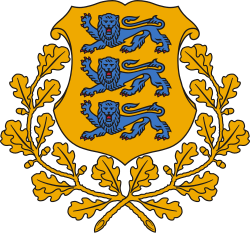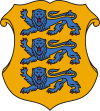Coat of arms of Estonia
| Coat of arms of Estonia | |
|---|---|
 |
|
| Versions | |

Lesser Arms
|
|
| Details | |
| Armiger | Republic of Estonia |
| Adopted | 6 April 1993 (19 June 1925) |
| Escutcheon | Or, three lions passant guardant azure, langued and armed gules |
| Other elements | A garland of oak leaves surrounds the greater arms |
The current coat of arms of Estonia is a golden shield which includes a picture of three blue lions with red tongues in the middle, with golden oak branches placed on both sides of the shield. The insignia derive from the coat of arms of Denmark, which ruled northern Estonia in the thirteenth century.
The coat of arms of Estonia depicts a golden shield, which includes three slim blue lions passant gardant with red tongues in the middle and golden oak branches along both sides of the shield. The lesser coat of arms lacks these oak branches. The three lions derive from the arms of Danish king Valdemar II who had conquered northern Estonia in 1219. The lions became part of the greater coat of arms of Tallinn, the centre of Danish government in Estonia, and the knightages (ger. ritterschaften) of Harria and Viru.
In 1346, Denmark sold its Estonian dominion to the Teutonic Order after its power had been severely weakened during the St. George's Night Uprising of 1343-1346. The three lions, however, remained the central element of the greater coat of arms of Tallinn. In later centuries, the motif of the three lions transferred to the coat of arms of the Duchy of Estonia, the Ritterschaft of Estland, and to the coat of arms of the Governorate of Estonia. The Riigikogu (the state assembly) of the independent Republic of Estonia officially adopted the coat of arms on June 19, 1925.
The coat of arms was officially banned following the occupation of Estonia by the Soviet Union in 1940, and replaced with the Soviet-inspired coat of arms of the Estonian SSR which consisted of a branch of the coniferous tree on the left, stalks of wheat on the right side and the red star on top. Soviet officials persecuted and jailed anyone using the coat of arms or the national colors of Estonia. The readoption of the national symbols, which was finally achieved on August 7, 1990, marked one of the high points in the struggle for the restoration of independent Estonia. The use of the coat of arms is regulated by the Law on State Coat of Arms, passed on April 6, 1993.
...
Wikipedia
